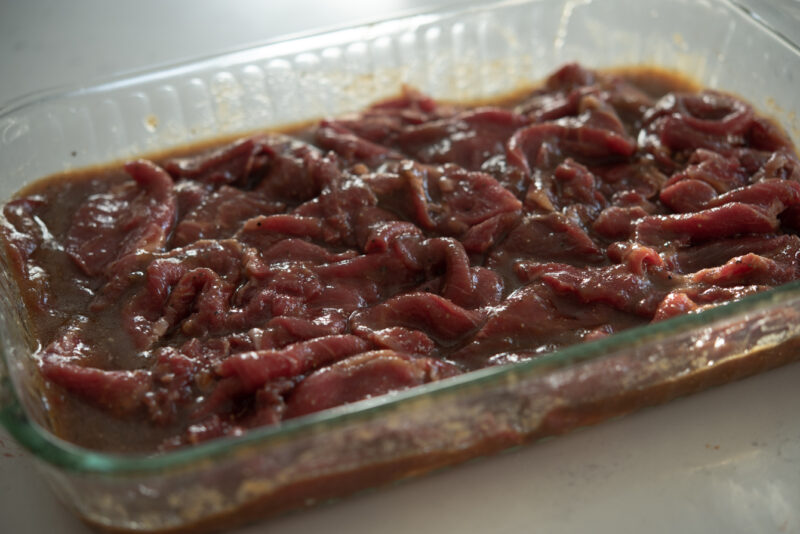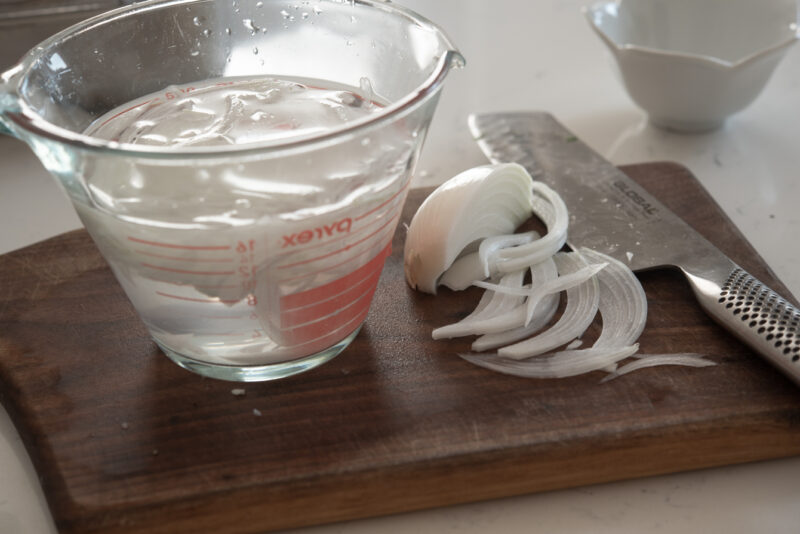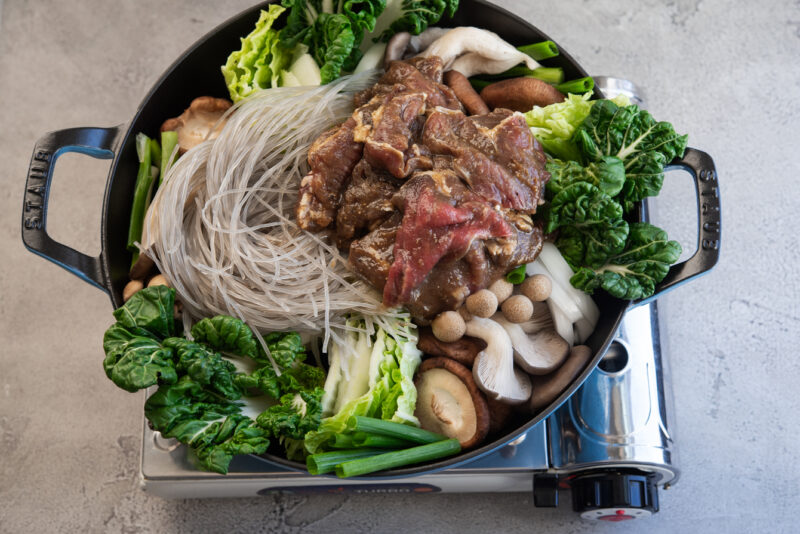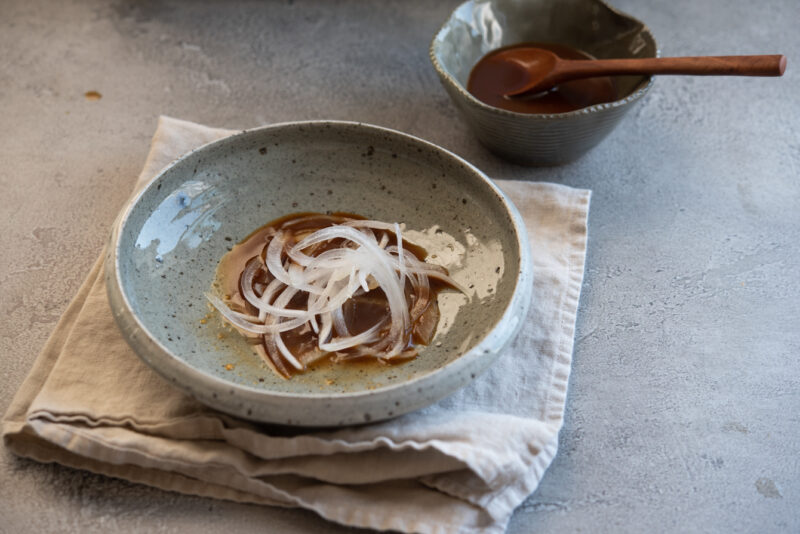Korean Beef Bulgogi Hot Pot (Bulgogi Jeongol)
Bulgogi hot pot (Jeongol) is a Korean beef hot pot dish with marinated bulgogi meat, a variety of vegetables, and glass noodles in a savory and slightly sweet broth. Typically served during cold winter months, this hearty, comforting Korean hot pot recipe is perfect for gatherings with family and friends.

As I review fond memories of winter time in Korea when I was growing up, I think of my mother preparing this delicious, savory bulgogi hot pot for dinner.
A large shallow pot is adorned with a beautiful arrangement of Korean beef bulgogi meat, along with a variety of leafy vegetables, mushrooms, and Korean glass noodles (dangmyeon). Then a slightly sweet and savory broth is poured over it all.
My mother placed the pot on a portable burner in the middle of table. The entire family of seven sat around the table and watched with anticipation as the hot pot steamed up and then began to boil.
Bulgogi jeongol cooks up fast. Within a short few minutes, this comforting and delicious Korean beef stew is ready. We each rushed to pick out, with a ladle, our favorite ingredient from the hot pot – for me, it was the mushroom – and dip it in the dipping sauce on our individual plate. It’s steaming hot, of course. So we had to cool down each morsel by blowing on it until we could eat it.
No matter how cold or bad the weather outside was, this soul-comforting Korean stew instantly warmed us up. So hearty and delicious!
What is Jeongol?
Jeongol is a Korean word for hot pot. It’s a one of the sophisticated Korean stew dishes cooked right at the table. There are a variety of ingredient options for jeongol, such as Korean bulgogi, fresh seafood, dumplings, mushroom, tofu, and fish cakes.
Whichever option you choose, always add leafy vegetables to balance the dish. Jeongol also requires a slightly sweet and savory broth, which flavors the dish, that you boil the ingredients in.
It is typically cooked in a wide and shallow pot (jeongol naembi) right at the table, so that you can enjoy the steaming hot jeongol right away. Use any large, shallow pot or pan. I used my braiser pan.

What Ingredients are good for Bulgogi Hot Pot?
- bulgogi – beef slices marinated in the bulgogi sauce in advance (see my Best bulgogi recipe). Or use a store-bought jarred bulgogi marinade.
- vegetables – use leafy vegetables: napa cabbage, spinach, bok choy, watercress, Swiss chard, choy sum, etc.
- mushroom – use a variety: shiitake, oyster, enoki, etc.
- tofu – either soft or firm (sliced)
- onion – leek, green onion, or chives are great, too.
- glass noodles (dangmyeon) – make sure to soak them in water to soften them up before adding them to the pot.
- broth – use anchovy kelp stock simmered with dried jujube. Then season with Korean soup soy sauce and sweet rice wine.
How to serve Korean Beef Hot Pot?
It is a good idea to get a portable burner so you can cook right on the table. You’ll want to enjoy the fresh hot pot instantly. Each person should have their own serving dish (a shallow bowl) so that they can ladle up their own portions as it cooks.
You can serve bulgogi jeongol as is, together with the savory broth. Alternatively, you can also dip the meat, vegetable, and mushroom in a simple dipping sauce to get an extra flavor boost.
How to make Bulgogi Jeongol at Home

Step 1. Marinate the beef with bulgogi sauce. See my best beef bulgogi recipe. Make sure to do this step well in advance, at least 2 hours or up to a day before you assemble the hot pot.

Step 2. Soak Korean glass noodles (dangmyeon) in warm water for 15 minutes. Drain and set aside.


Step 3. Make the savory broth. Simmer together dried anchovies, dried sea kelp (dashima), dried jujube (daechu), and whole peppercorn (optional) over low heat for 10 minutes. Remove the sea kelp halfway through your simmering time. Discard the anchovies, jujube, peppercorn and reserve the stock. Season the broth with Korean soup soy sauce and sweet rice wine.

Step 4. Prepare other ingredients of your choice. I am using napa cabbage, bok choy, shiitake mushroom, oyster mushroom, enoki mushroom, onion, green onion.


Step 5. I recommend adding fresh raw onion when you serve the hot pot. Soak the thin onion slices in cold water for a few minutes to crisp them up. To make the dipping sauce, combine soy sauce, vinegar, sugar, and Korean mustard in a small jar and shake the jar vigorously to emulsify the sauce.

Step 5. Assemble the hot pot ingredients, placing them in a pleasing way for presentation, and then pour the savory stock over them. The stock should not reach all the way to the top. You can add more stock as you cook.

Step 6. Place the pot over the portable burner and let it boil over medium-high heat. When the broth is starting to boil, spread the beef around so it cooks evenly.


How to serve bulgogi hotpot
When meat is cooked, and the vegetables, mushrooms, and noodles are tender, dish the items up on to your serving dish and serve with dipping sauce. Also try with Korean green onion salad as well.
Other Korean Comfort Dishes


Korean Beef Bulgogi Hot Pot (Bulgogi Jeongol)
Ingredients
For savory broth
- 7 large dried anchovy
- 1 large dried sea kelp (dashima)
- 4 dried jujube (daechu)
- 2 tsp whole peppercorn, optional
- 6 cup water
- 2 tbsp Korean soup soy sauce (gukganjang)
- 2 tbsp sweet rice wine (mirim)
- salt to taste
For bulgogi hotpot
- 1/2 lb Korean beef bulgogi, marinated, or use a store-bought bulgogi sauce to marinade the beef
- 3 oz Korean glass noodles (dangmyeon)
- 1/4 napa cabbage, sliced
- 8 oz baby bok choy, halved
- 4 oz each mushroom (shiitake, oyster, and enoki mushroom), or use other favorite mushrooms
- 1/2 medium onion , sliced
- 4 green onion, sliced
For dipping sauce
- 6 tbsp soy sauce
- 4 tbsp rice vinegar
- 1 1/2 tbsp sugar
- 2 tsp Korean mustard (yeongeoja), or dijon mustard
- 1/2 white onion, thinly sliced, optional
Equipment
Instructions
For the savory broth
- For the savory broth, simmer together dried anchovies, dried sea kelp, and dried jujube over low heat for 10 minutes. Remove the sea kelp halfway through your simmering time. Discard the anchovies and jujube, and reserve the stock.
- Season the broth with Korean soup soy sauce and sweet rice wine. Taste and add salt in needed. Be careful not to overly season; set it aside.
For the hot pot
- Soak Korean glass noodles in warm water for 15 minutes. Drain and set aside.
- Prepare other hot pot ingredients and to large bite size pieces and set aside.
- In a 3-4 qt braiser pan or a shallow pot, assemble the hot pot ingredients, placing them in a pleasing way for presentation, and then pour the savory broth over them. The broth should not reach all the way to the top. You can add more stock as you cook.
- Place the pot over the portable burner in the middle of table, and let it boil over medium-high heat. When the broth is starting to boil, spread the beef around so it cooks evenly.
- When meat is cooked, and the vegetables, mushrooms, and noodles are tender, dish the items up on to your serving dish and serve with dipping sauce and crisped raw onion (optional).
For the dipping sauce
- If you are using the onion, I recommend soaking the thin onion slices in cold water for a few minutes to crisp them up.
- Combine soy sauce, vinegar, sugar, and Korean mustard in a small jar and shake the jar vigorously to emulsify the sauce.
This recipe was originally posted in November 2010. I’ve updated the recipe with minor changes, new photos, and more information.


Fantastic dish and easy on the eyes. I wish you had included the bulgogi marinade ingredients. I just used thinly sliced beef.
Yum! It’s been really cold here recently, so this looks so warming and appealing. Terrific dish — tons of flavor. Thanks!
I like the way you write your instructions..very entertaining and not just some boring recipe! Reading how you soften the noodles’ attitude really made me laugh. Keep it up! 🙂
Wonderful…but you need RICE!!! No satisfaction for me without a bowl of rice.
I love your recipes, they are AUTHENTIC korean recipes and not the americanized version recipes.
love this! the bulgogi must go so well with the dangmyeon.